Two Door Saloon (OHC) KJ 1664
Moderators: Ian Grace, Will Grace
Two Door Saloon (OHC) KJ 1664
A friend of mine has the task of reviving his late father in law's out-building stored, untouched for 11 plus years, 1931 Minor two door saloon.
Apparently, it was in superb condition prior to being stored, but has suffered a little during its long slumber. The most immediate issue is getting it to run and hopefully drive too.
So far I think we're passed the stale fuel stage, we've tested the electrics but haven't really been able to completely rule out plugs, HT leads, distributor cap, rotor arm, points or condenser as possible weak leaks as these probably need to be substituted to eliminate them. We have a new coil and battery though and plenty of 'Easy Start'. I haven't dismantled the carburettor yet, but am wary of ripping everything to bits as that carries significant risks with 90 year old parts. I don't want to smother the car with enthusiasm and make things worse in the process. I would hope that the Easy Start would have provided some pops and bangs and perhaps even a short burst of life even if the carburettor was lethargic.
The starter is still a little sluggish (less so now that we've cleaned and tightened the connections). The battery is new and matches the one that was removed, but is only about 58 amp hour. I understand that the 80 amp hour alternatives are preferred. The engine now turns over on the starter (as enthusiastically as any 6V starter, I suspect), but the spark is pretty feeble. The car failed to start last time it was moved (many years ago) and sadly, it has yet to run for us!
Ian Grace has suggested that I start this thread and post some pictures. If there are none to be seen, then I won't yet have been up to the technical challenge of uploading them, but I have been promised assistance if required!
I have a fair bit of experience with 1960s cars from my early days as a motorist in the 1970s on a young man's budget. I have also carried out quite a few tasks on my daughter's 1953 Riley RME. However, pre-war cars with six volt electrics are a new challenge for me, especially as my old school 12 volt diagnostic tools can't be used (dwell gauges, timing lights and the like). Well, it's a challenge!
Regards,
Philip
Apparently, it was in superb condition prior to being stored, but has suffered a little during its long slumber. The most immediate issue is getting it to run and hopefully drive too.
So far I think we're passed the stale fuel stage, we've tested the electrics but haven't really been able to completely rule out plugs, HT leads, distributor cap, rotor arm, points or condenser as possible weak leaks as these probably need to be substituted to eliminate them. We have a new coil and battery though and plenty of 'Easy Start'. I haven't dismantled the carburettor yet, but am wary of ripping everything to bits as that carries significant risks with 90 year old parts. I don't want to smother the car with enthusiasm and make things worse in the process. I would hope that the Easy Start would have provided some pops and bangs and perhaps even a short burst of life even if the carburettor was lethargic.
The starter is still a little sluggish (less so now that we've cleaned and tightened the connections). The battery is new and matches the one that was removed, but is only about 58 amp hour. I understand that the 80 amp hour alternatives are preferred. The engine now turns over on the starter (as enthusiastically as any 6V starter, I suspect), but the spark is pretty feeble. The car failed to start last time it was moved (many years ago) and sadly, it has yet to run for us!
Ian Grace has suggested that I start this thread and post some pictures. If there are none to be seen, then I won't yet have been up to the technical challenge of uploading them, but I have been promised assistance if required!
I have a fair bit of experience with 1960s cars from my early days as a motorist in the 1970s on a young man's budget. I have also carried out quite a few tasks on my daughter's 1953 Riley RME. However, pre-war cars with six volt electrics are a new challenge for me, especially as my old school 12 volt diagnostic tools can't be used (dwell gauges, timing lights and the like). Well, it's a challenge!
Regards,
Philip
Re: Two Door Saloon (OHC) KJ 1664
Is there a spark at the plugs?
Take one out, clean it and connect an earth to the plug body, reconnect the plug lead. Make sure car is in neutral. With ignition on turn the engine on the starting handle and look for a spark. If so refit the plug.
Disconnect the wire to the fuel pump and secure it to prevent any unwanted sparks. Fully retard the distributor.
Take the top off the carburettor float chamber and fill with fresh petrol. Put the top back on. Apply some choke.
Turn the engine on the starter. If no success timing may be out or points may need cleaning and adjusting.
Other things to look for are corroded contacts in the distributor and coil leads, check the ends have a good contact and there are no internal breaks. The coil and condenser can also be faulty and the carburettor blocked. But look for the simple things first.
Apologies if you know all this.
Let us know how you get on...
Take one out, clean it and connect an earth to the plug body, reconnect the plug lead. Make sure car is in neutral. With ignition on turn the engine on the starting handle and look for a spark. If so refit the plug.
Disconnect the wire to the fuel pump and secure it to prevent any unwanted sparks. Fully retard the distributor.
Take the top off the carburettor float chamber and fill with fresh petrol. Put the top back on. Apply some choke.
Turn the engine on the starter. If no success timing may be out or points may need cleaning and adjusting.
Other things to look for are corroded contacts in the distributor and coil leads, check the ends have a good contact and there are no internal breaks. The coil and condenser can also be faulty and the carburettor blocked. But look for the simple things first.
Apologies if you know all this.
Let us know how you get on...
Re: Two Door Saloon (OHC) KJ 1664
Thank you for the suggestions, Peter.
We have tried the 'spark plug against the engine test', which is what prompted the 'feeble spark' observation. I have tested the LT side with a multimeter, just about every way imaginable - voltage and resistance. The plugs were rather dirty, so we cleaned the contacts, but they may well be too mucky inside to provide a decent spark. It is the things that I can't test effectively (the condenser and most of the HT side) that lead me to testing by substitution, but it does appear to me trickier to obtain 1930s parts than it is 1950s ones.
We have drained the fuel tank and replenished it with fresh fuel. The carburettor appeared to be dry after 11 or so years of standing with the fuel tap in the 'off' position, although I am aware that it could be gummed up inside. I was able to confirm that fuel is flowing through the pipe to the carburettor - gravity fed of course on the models with the firewall mounted fuel tank. Inspecting and cleaning the carburettor is one of the next steps, but I don't believe that we're getting a good enough spark. We have been setting the manual advance/retard control to fully retarded (and other settings in desperation too), plus we have set the confusing 'mixture control' fully in (as opposed to a choke lever inspired fully out setting - with some random variation just in case). I have been reluctant to pull the carburettor apart so far, partly due to the poor sparks (and poor starter motor speed), but mainly because I would expect the EasyStart to provide sufficient combustibility to at least obtain a few pops and bangs, possibly even a few seconds of running.
The engine hasn't been messed about with since it last ran and the points do open and close effectively. The rather twee 1930 manual that came with the vehicle only describes points gap settings. Checking the timing thoroughly is going to necessitate some research first. With my daughter's 1953 Riley RME, this involves the use of a dial gauge to determine number one cylinder TDC, some custom paint marks on the pulley/block and the use of a 12v timing light. I'm not sure how that would work on a 6v system (maybe I could power the electronics with a twelve volt battery and have a common earth with the vehicle chassis to detect the spark energy?). The Riley manual does at least provide ignition advance details - not much help for a 1931 Morris though! Maybe the forum holds the answer somewhere?
I have been in touch with Ian Harris, with a view to obtaining the parts needed for the substitution testing. I haven't been beaten yet with a 12v system, but pre war vehicles are a new challenge for me.
Thanks again for your help. I will keep the thread updated.
Regards,
Philip
We have tried the 'spark plug against the engine test', which is what prompted the 'feeble spark' observation. I have tested the LT side with a multimeter, just about every way imaginable - voltage and resistance. The plugs were rather dirty, so we cleaned the contacts, but they may well be too mucky inside to provide a decent spark. It is the things that I can't test effectively (the condenser and most of the HT side) that lead me to testing by substitution, but it does appear to me trickier to obtain 1930s parts than it is 1950s ones.
We have drained the fuel tank and replenished it with fresh fuel. The carburettor appeared to be dry after 11 or so years of standing with the fuel tap in the 'off' position, although I am aware that it could be gummed up inside. I was able to confirm that fuel is flowing through the pipe to the carburettor - gravity fed of course on the models with the firewall mounted fuel tank. Inspecting and cleaning the carburettor is one of the next steps, but I don't believe that we're getting a good enough spark. We have been setting the manual advance/retard control to fully retarded (and other settings in desperation too), plus we have set the confusing 'mixture control' fully in (as opposed to a choke lever inspired fully out setting - with some random variation just in case). I have been reluctant to pull the carburettor apart so far, partly due to the poor sparks (and poor starter motor speed), but mainly because I would expect the EasyStart to provide sufficient combustibility to at least obtain a few pops and bangs, possibly even a few seconds of running.
The engine hasn't been messed about with since it last ran and the points do open and close effectively. The rather twee 1930 manual that came with the vehicle only describes points gap settings. Checking the timing thoroughly is going to necessitate some research first. With my daughter's 1953 Riley RME, this involves the use of a dial gauge to determine number one cylinder TDC, some custom paint marks on the pulley/block and the use of a 12v timing light. I'm not sure how that would work on a 6v system (maybe I could power the electronics with a twelve volt battery and have a common earth with the vehicle chassis to detect the spark energy?). The Riley manual does at least provide ignition advance details - not much help for a 1931 Morris though! Maybe the forum holds the answer somewhere?
I have been in touch with Ian Harris, with a view to obtaining the parts needed for the substitution testing. I haven't been beaten yet with a 12v system, but pre war vehicles are a new challenge for me.
Thanks again for your help. I will keep the thread updated.
Regards,
Philip
Re: Two Door Saloon (OHC) KJ 1664
Photos sent in by Philip:
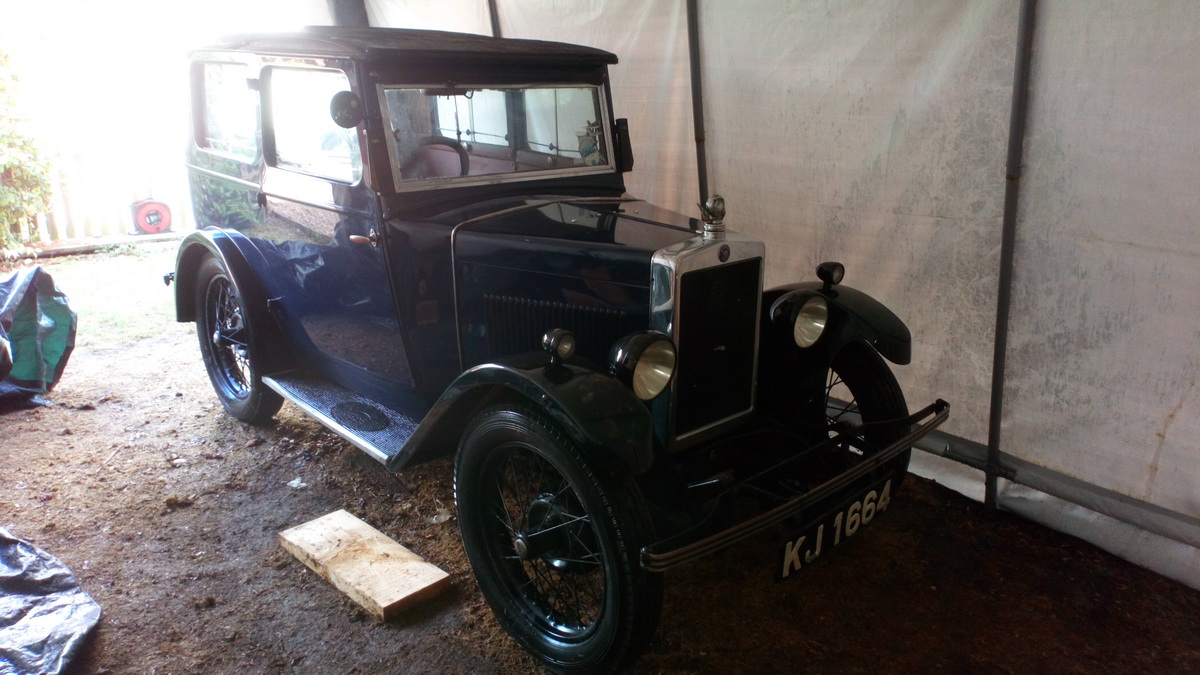
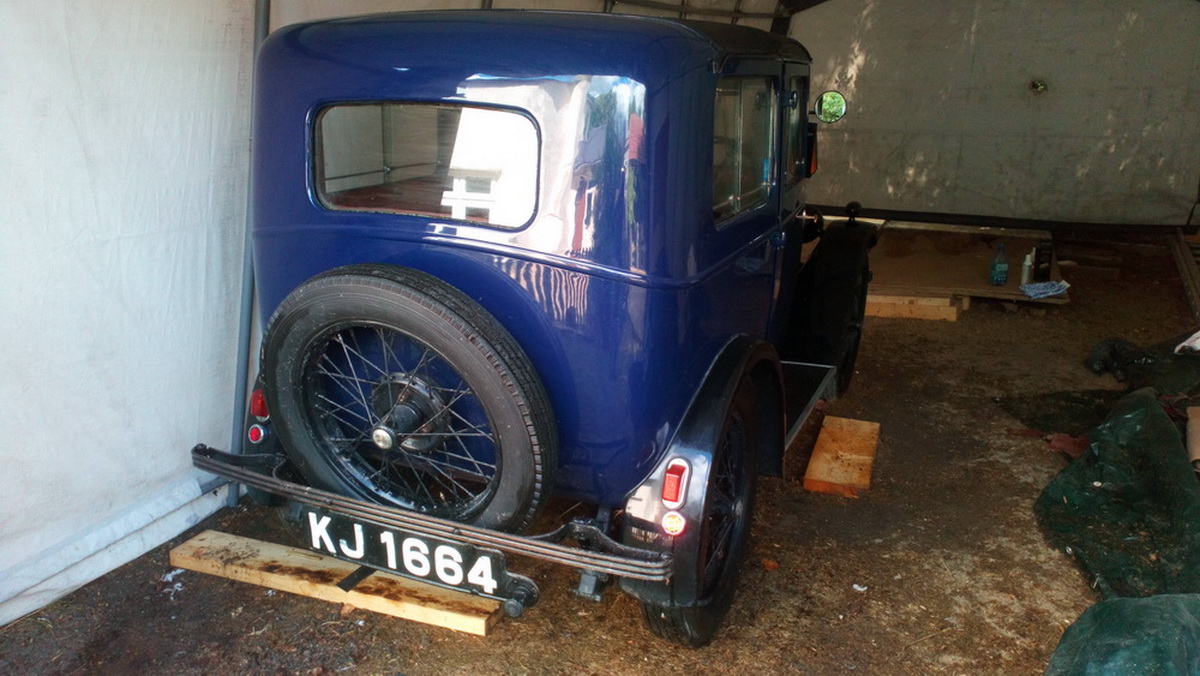
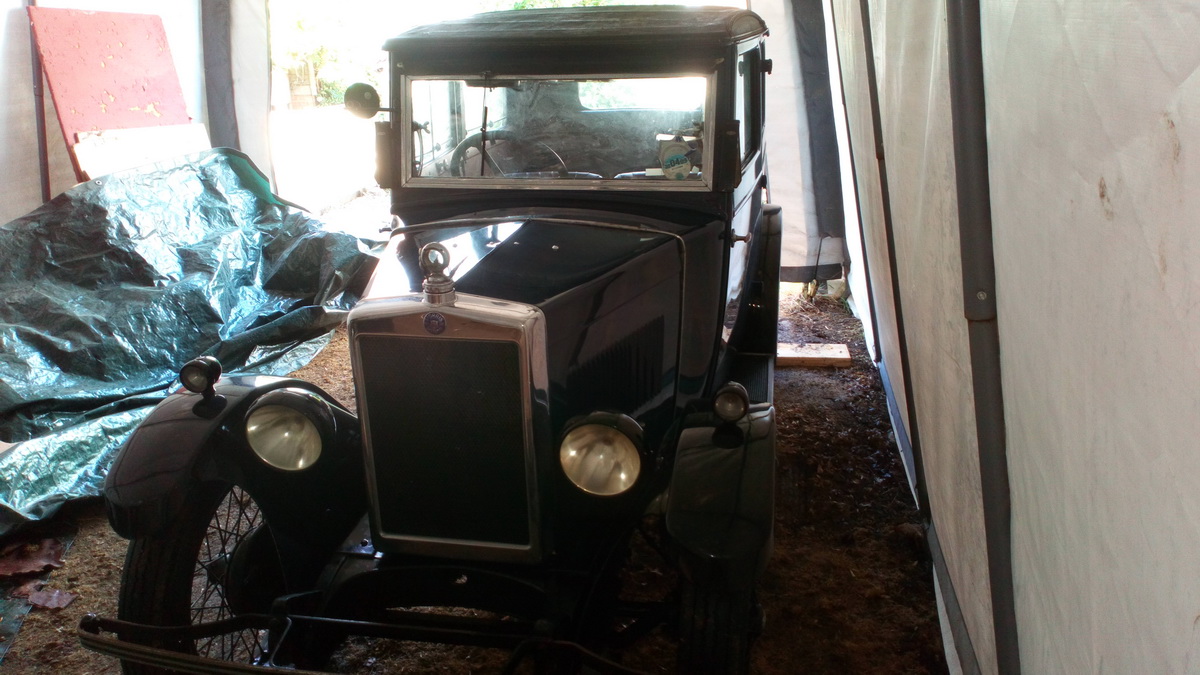
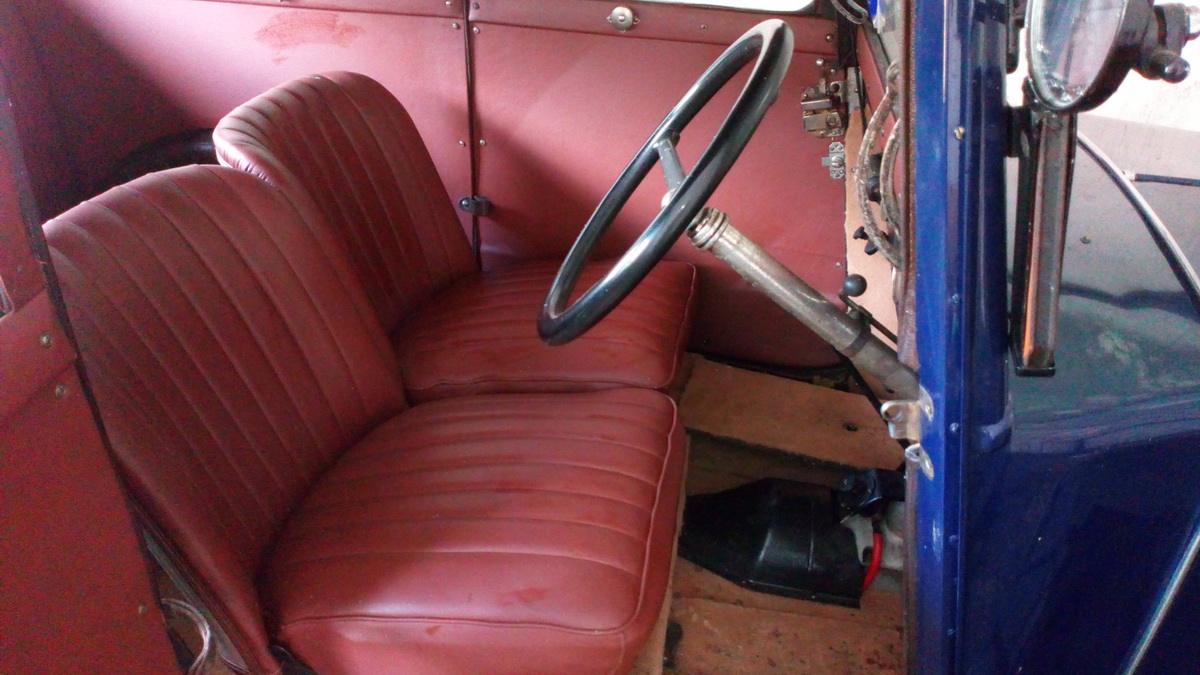
Re: Two Door Saloon (OHC) KJ 1664
Looks like you got a bargain Philip!
This photo from the VMR archives.
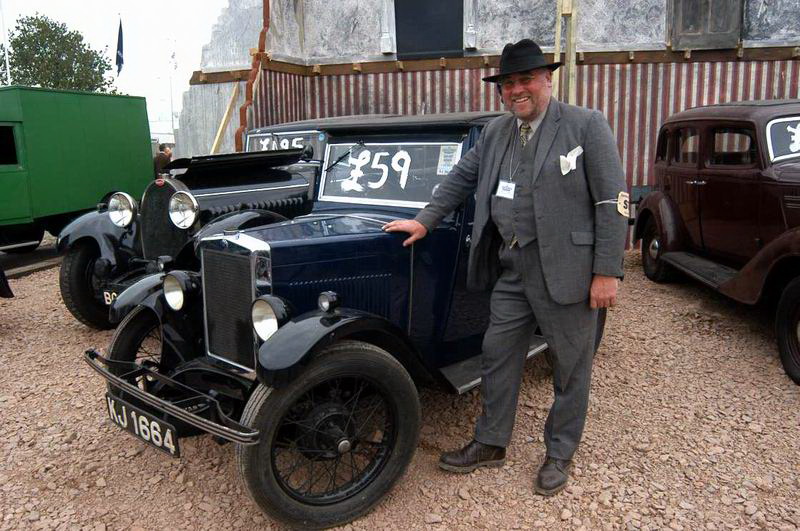
This photo from the VMR archives.
Re: Two Door Saloon (OHC) KJ 1664
Here's the SV ignition timing, taken from the original SV Minor service sheet in the VMR Members' Area. Should be good for the OHC engine as well, I believe.
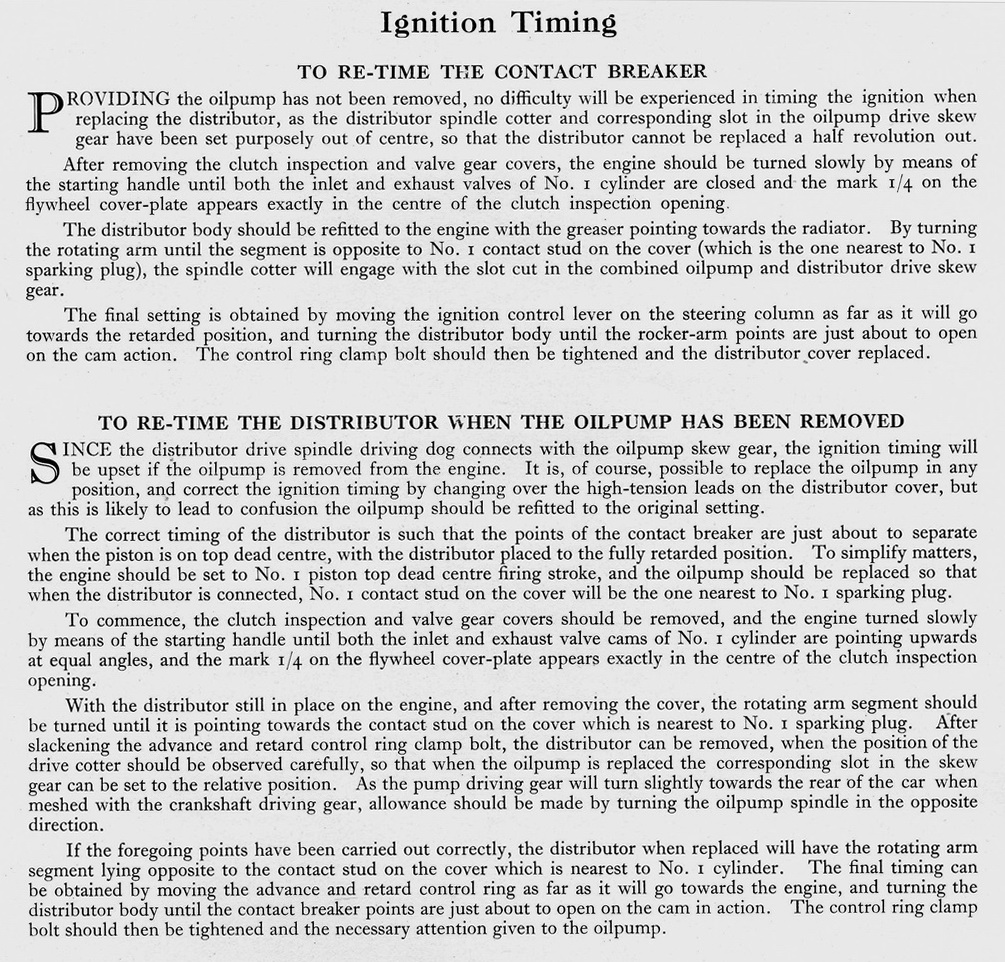
Re: Two Door Saloon (OHC) KJ 1664
Nice motor Philip.
Very frustrating.
It will come as no surprise that anyone with a vintage Minor has been there !
If Ian Harris hasn't got the parts you need there are a several other places to try.
Condensers can be found here... and any other distributor parts.
Just let them know what model distributor you have.
http://www.distributordoctor.com/distri ... ensers.htm
MORRIS ENGINES ORIGINAL CHART Timing for the 1931 OHV Minor is as follows -
INLET Opens 9º after TDC. Closes 35º after BDC
EXHAUST Opens 43º before BDC. Closes 7º after TDC
IGNITION FULLY RETARDED AT TOP DEAD CENTRE
Tappet clearance - Inlet 0.003" Exhaust 0.003"
(there is some doubt as to wether this is the hot or cold setting, so a couple of thou extra cold to begin with might be a wise precaution)
Your strobe light idea should work. On my '34 engine the flywheel has TDC marked on it, visible through the cover on the gearbox. (2 bolts)
Plenty more information about finding TDC and setting timing available.
Very frustrating.
It will come as no surprise that anyone with a vintage Minor has been there !
If Ian Harris hasn't got the parts you need there are a several other places to try.
Condensers can be found here... and any other distributor parts.
Just let them know what model distributor you have.
http://www.distributordoctor.com/distri ... ensers.htm
MORRIS ENGINES ORIGINAL CHART Timing for the 1931 OHV Minor is as follows -
INLET Opens 9º after TDC. Closes 35º after BDC
EXHAUST Opens 43º before BDC. Closes 7º after TDC
IGNITION FULLY RETARDED AT TOP DEAD CENTRE
Tappet clearance - Inlet 0.003" Exhaust 0.003"
(there is some doubt as to wether this is the hot or cold setting, so a couple of thou extra cold to begin with might be a wise precaution)
Your strobe light idea should work. On my '34 engine the flywheel has TDC marked on it, visible through the cover on the gearbox. (2 bolts)
Plenty more information about finding TDC and setting timing available.
Re: Two Door Saloon (OHC) KJ 1664
Thanks for resizing and posting my pictures, Ian.
The other picture looks like a recreation of a second hand car lot, complete with appropriately dressed 'spiv' - presumably at a car show? Is there any more information about the circumstances of the picture? £95 would indeed be a bargain.
Thanks also for the ignition timing instructions. Looks straight forward, with not a dial gauge or strobe light in sight!
The other picture looks like a recreation of a second hand car lot, complete with appropriately dressed 'spiv' - presumably at a car show? Is there any more information about the circumstances of the picture? £95 would indeed be a bargain.
Thanks also for the ignition timing instructions. Looks straight forward, with not a dial gauge or strobe light in sight!
Re: Two Door Saloon (OHC) KJ 1664
Thank you Peter.
I have to stress that the car belongs to a friend's mother in law, following the passing of her husband. We hope to get the car to run and drive as a minimum and to return it to the state it was in before storage if possible. Once we've done that, the family will have to decide what they want to do with it. I already own more cars and motorbikes than is sensible, but you never know - I might be a customer!
Thanks too for the timing and parts information. I believe the distributor is a DS4, which I understand is rarer, perhaps because it's an OHC engine?
Never a dull moment with old cars!
I have to stress that the car belongs to a friend's mother in law, following the passing of her husband. We hope to get the car to run and drive as a minimum and to return it to the state it was in before storage if possible. Once we've done that, the family will have to decide what they want to do with it. I already own more cars and motorbikes than is sensible, but you never know - I might be a customer!
Thanks too for the timing and parts information. I believe the distributor is a DS4, which I understand is rarer, perhaps because it's an OHC engine?
Never a dull moment with old cars!
Re: Two Door Saloon (OHC) KJ 1664
The sales photo came from John Fisher when he advertised the car in one of out 2004 Magazines. I believe it was part of a display at Goodwood around that time. You might like to contact John at the details below. I'm sure he would be pleased to hear from you. (Note, he quoted the chassis number as 34892, that's the engine number I believe.)
1931 Morris Minor Coachbuilt Saloon KJ 1664 (M34892)
First registered 9th July 1931
Dark blue with black wings. There are no dents or damage and the paint job is excellent. The interior is all original, but in good condition except the front seat squabs which are showing their age. Engine overhauled by Tim Myall.
£4,995 ovno (and NOT £59!)
John Fisher, Sunnymead, Mill Lane, Hookwood, Surrey, RH6 0HX
01293/773334
the4fishers@eurobell.co.uk
1931 Morris Minor Coachbuilt Saloon KJ 1664 (M34892)
First registered 9th July 1931
Dark blue with black wings. There are no dents or damage and the paint job is excellent. The interior is all original, but in good condition except the front seat squabs which are showing their age. Engine overhauled by Tim Myall.
£4,995 ovno (and NOT £59!)
John Fisher, Sunnymead, Mill Lane, Hookwood, Surrey, RH6 0HX
01293/773334
the4fishers@eurobell.co.uk
Re: Two Door Saloon (OHC) KJ 1664
It was for sale again by Brian and Wendy Fiddler through dealer Gavin McGuire in 2006 - see the entry for 7/9/06 on the website home page.
Re: Two Door Saloon (OHC) KJ 1664
Well, a month on and lots of activity but the engine is still not running. It's a 150 mile round trip each time I visit the car, which is time consuming. Worse still, it prevents those brief half hour tinkering sessions followed by an hour's reflection and then a return to implement the latest 'eureka' thought. Perhaps this is a special kind of Morris Minor performance anxiety?
We've been through the static timing process with the inspection cover off. Here though, previous experience with 1950s and 1960s cars may have been a hindrance. On those vehicles, once the relevant engine marks are lined up, it is a simple matter to slacken the distributor off, turn it against the direction of movement (to close the points) and then tease forward until the points spark (or the strategically connected bulb lights, depending on your preference), et voilà, static timing set! With the Minor, I'm a little stuck at the 'slacken the distributor bolt' instructions as I don't know what I'm looking for (poor lighting in the covering temporary building doesn't help). There is an adjuster of sorts on the distributor (on the engine side), but whilst it screws in and out, I can't see what it actually does.
Notwithstanding all this, I am confident that the spark is occurring at or around the 'most retarded' setting. I am now less confident about the positioning of the HT leads in the distributor cap. The leads are set in 1, 3, 4, 2 order (clockwise), but when checking the static timing, it did appear that the rotor arm was pointing to number two position when the 1/4 marks were showing on the clutch/flywheel. We tried moving the HT leads anticlockwise one position, but still no joy.
We bit the bullet and removed the carburettor to inspect inside. There was some detritus in the float chamber, but generally the insides were clean, with no nasty green residue anywhere. The needle moves easily and the damper works well. The seal of the banjo connection between the float bowl and the carburettor body wasn't great (it was weeping) and still isn't great after reassembly. Maybe new washers would be in order? Are fibre washers better than un-annealed copper ones?
If anyone could offer any advice I would be very grateful. To recap, I'm stuck on the details of slackening/re-clamping the distributor for static timing and on just exactly where number one HT lead should be on the distributor cap (perhaps in relation to the cap clamps or any other easily identifiable reference point). Also, what is the adjuster on the distributor for (the one that looks rather like the end of a micrometer)?
Thank you for reading this far!
We've been through the static timing process with the inspection cover off. Here though, previous experience with 1950s and 1960s cars may have been a hindrance. On those vehicles, once the relevant engine marks are lined up, it is a simple matter to slacken the distributor off, turn it against the direction of movement (to close the points) and then tease forward until the points spark (or the strategically connected bulb lights, depending on your preference), et voilà, static timing set! With the Minor, I'm a little stuck at the 'slacken the distributor bolt' instructions as I don't know what I'm looking for (poor lighting in the covering temporary building doesn't help). There is an adjuster of sorts on the distributor (on the engine side), but whilst it screws in and out, I can't see what it actually does.
Notwithstanding all this, I am confident that the spark is occurring at or around the 'most retarded' setting. I am now less confident about the positioning of the HT leads in the distributor cap. The leads are set in 1, 3, 4, 2 order (clockwise), but when checking the static timing, it did appear that the rotor arm was pointing to number two position when the 1/4 marks were showing on the clutch/flywheel. We tried moving the HT leads anticlockwise one position, but still no joy.
We bit the bullet and removed the carburettor to inspect inside. There was some detritus in the float chamber, but generally the insides were clean, with no nasty green residue anywhere. The needle moves easily and the damper works well. The seal of the banjo connection between the float bowl and the carburettor body wasn't great (it was weeping) and still isn't great after reassembly. Maybe new washers would be in order? Are fibre washers better than un-annealed copper ones?
If anyone could offer any advice I would be very grateful. To recap, I'm stuck on the details of slackening/re-clamping the distributor for static timing and on just exactly where number one HT lead should be on the distributor cap (perhaps in relation to the cap clamps or any other easily identifiable reference point). Also, what is the adjuster on the distributor for (the one that looks rather like the end of a micrometer)?
Thank you for reading this far!
Re: Two Door Saloon (OHC) KJ 1664
Hello Phillip
Sorry to hear your woes.
Carburettor service kits are available from Burlen SU in various combinations. The basic washer, gasket and jet kit is a good staring point. Just input the carb model on their website. Most of the washers are fibre and there's a metal/fibre washer sandwich between the float chamber and the carb body.
I apologise for the following lengthy discourse as I'm sure you know all this, but some distributors rotate the opposite way, etc.etc.
Do you know what model of distributor the car has? It can usually be found on a small embossed plate just under the body.
My Minor is a later car and has a DJ-4 also common to other models. It has manual advance / retard. This is how I set mine.
The body and cap have one flat side. This is normally facing forwards, and at an angle, but it isn't critical.
What is important is that, when No.1 piston is at top dead centre, the 1/4 marks on the flywheel are in the middle of the inspection cover opening on the gearbox. The distributor is turned fully clockwise to the retarded position and the rotor arm is pointing at the plug lead for No.1 cylinder. (usually at about 1 o'clock or towards the top of the flat part)
As you say the firing order is 1,3,4,2 so turning the engine by hand and watching the rotor arm move clockwise will show you the right firing order for the plug leads. Make sure it's definitely No.1 piston at TDC because it's possible to be 180º out. Put a thumb over the spark plug hole to check for the compression stroke.
The distributor has a clamp on the shaft with a nut and bolt. This has to be slackened to alter the timing. I.e. points just beginning to open at TDC when fully retarded. When that is set tighten the bolt and check the fully advanced timing. Move the flywheel clockwise so the 1/4 mark is opposite the RH edge of the inspection hole. Turn the distributor anticlockwise to the fully advanced position which is 20º before TDC. There will be slack in the drive system so keep the rotor arm turned clockwise while making adjustments.
I think the little knurled knob, like a micrometer, you mention, fitted to the shaft is the greaser and nothing to do with adjusting timing.
It's a small cap which unscrews and can be filled with grease. A couple of turns in, every 500 miles, keeps the shaft lubricated.
Another check - Take a plug out, connect the lead, lay it on the engine block and with the ignition turned on - and the car in neutral - crank on the handle to confirm there is a spark. Also flicking the points open with ignition on will make a weak spark.
The carburettor setting on my car is as follows. Set the idle screw to 1 1/2 turns open. Take off the piston cover and carefully remove the piston. Turn the jet adjusting nut up as far as it will go, then push the jet upwards and check it is level with the bridge. If it is above, turn the nut down slightly. Turn the jet nut down 12 flats (2 full turns). Check the jet tube is still pushed up against the nut. Carefully replace the piston and cover. When the piston is raised with a finger it should drop freely with a click. If it doesn't the jet will have to centered (but I'll assume for the moment it's ok). When the float bowl is full and the choke is pulled fully out it may be possible to detect petrol coming out of the jet hole inside the carburettor. The float chamber valve needs to be set correctly but is fairly tolerant if slightly off.
Now there is fuel and a spark what could possibly go wrong !
- well there may be an issue with the coil or the condenser or few other things.... but this is just for starters.
Do keep posting progress. it is very helpful to anyone in a similar situation.
Sorry to hear your woes.
Carburettor service kits are available from Burlen SU in various combinations. The basic washer, gasket and jet kit is a good staring point. Just input the carb model on their website. Most of the washers are fibre and there's a metal/fibre washer sandwich between the float chamber and the carb body.
I apologise for the following lengthy discourse as I'm sure you know all this, but some distributors rotate the opposite way, etc.etc.
Do you know what model of distributor the car has? It can usually be found on a small embossed plate just under the body.
My Minor is a later car and has a DJ-4 also common to other models. It has manual advance / retard. This is how I set mine.
The body and cap have one flat side. This is normally facing forwards, and at an angle, but it isn't critical.
What is important is that, when No.1 piston is at top dead centre, the 1/4 marks on the flywheel are in the middle of the inspection cover opening on the gearbox. The distributor is turned fully clockwise to the retarded position and the rotor arm is pointing at the plug lead for No.1 cylinder. (usually at about 1 o'clock or towards the top of the flat part)
As you say the firing order is 1,3,4,2 so turning the engine by hand and watching the rotor arm move clockwise will show you the right firing order for the plug leads. Make sure it's definitely No.1 piston at TDC because it's possible to be 180º out. Put a thumb over the spark plug hole to check for the compression stroke.
The distributor has a clamp on the shaft with a nut and bolt. This has to be slackened to alter the timing. I.e. points just beginning to open at TDC when fully retarded. When that is set tighten the bolt and check the fully advanced timing. Move the flywheel clockwise so the 1/4 mark is opposite the RH edge of the inspection hole. Turn the distributor anticlockwise to the fully advanced position which is 20º before TDC. There will be slack in the drive system so keep the rotor arm turned clockwise while making adjustments.
I think the little knurled knob, like a micrometer, you mention, fitted to the shaft is the greaser and nothing to do with adjusting timing.
It's a small cap which unscrews and can be filled with grease. A couple of turns in, every 500 miles, keeps the shaft lubricated.
Another check - Take a plug out, connect the lead, lay it on the engine block and with the ignition turned on - and the car in neutral - crank on the handle to confirm there is a spark. Also flicking the points open with ignition on will make a weak spark.
The carburettor setting on my car is as follows. Set the idle screw to 1 1/2 turns open. Take off the piston cover and carefully remove the piston. Turn the jet adjusting nut up as far as it will go, then push the jet upwards and check it is level with the bridge. If it is above, turn the nut down slightly. Turn the jet nut down 12 flats (2 full turns). Check the jet tube is still pushed up against the nut. Carefully replace the piston and cover. When the piston is raised with a finger it should drop freely with a click. If it doesn't the jet will have to centered (but I'll assume for the moment it's ok). When the float bowl is full and the choke is pulled fully out it may be possible to detect petrol coming out of the jet hole inside the carburettor. The float chamber valve needs to be set correctly but is fairly tolerant if slightly off.
Now there is fuel and a spark what could possibly go wrong !
- well there may be an issue with the coil or the condenser or few other things.... but this is just for starters.
Do keep posting progress. it is very helpful to anyone in a similar situation.
- Attachments
-
- distributor-DJ4.jpg (79.3 KiB) Viewed 3867 times
Re: Two Door Saloon (OHC) KJ 1664
Another image that shows the usual distributor orientation for No. 1 cylinder with a DJ-4 distributor.
Your car may be different but if the firing order and plug leads are correctly connected it will work whichever way it's set.
On my car the distributor is turned so the rotor arm is at 1 o'clock rather than 11 and the flat edge is more vertical.
Does your distributor have a round base without a flat edge? I think a DSR type was fitted to 1930 OHC Minors.
Your car may be different but if the firing order and plug leads are correctly connected it will work whichever way it's set.
On my car the distributor is turned so the rotor arm is at 1 o'clock rather than 11 and the flat edge is more vertical.
Does your distributor have a round base without a flat edge? I think a DSR type was fitted to 1930 OHC Minors.
- Attachments
-
- dis.jpg (62.06 KiB) Viewed 3858 times
Re: Two Door Saloon (OHC) KJ 1664
Peter, in a word - brilliant!
Thank you so much for taking the time to put together a step by step guide. Whilst I am familiar with the process of static timing, pre-war cars and the Morris Minor in particular are outside my comfort zone. Two points in particular may well provide the 'euraka' moment:
The first is the description of the rotor arm positioning and the 20º timing method. This will hopefully give me the confidence to have the courage of my convictions when setting static timing and checking the leads/cap/rotor arm alignment.
The second is the position of the distributor clamp bolt (the picture was a real bonus). Mentally, I couldn't get past the moving advance/retard plate as it was outside my experience and I completely missed what should have been obvious. I believe Homer Simpson would say "d'oh"!
Thank you again for your posts. I had pretty much resigned myself to defeat, but I now feel enthused for another 150 mile trip!
I will indeed keep everyone posted.
As a quick aside, if anyone watches the 'Furious Driving' channel on Youtube, Matt has recently posted a short video about a 1930 Morris Minor: https://www.youtube.com/watch?v=PZBFR-jxb9U. Matt has a very honest and disarming style, well worth viewing.
Thank you so much for taking the time to put together a step by step guide. Whilst I am familiar with the process of static timing, pre-war cars and the Morris Minor in particular are outside my comfort zone. Two points in particular may well provide the 'euraka' moment:
The first is the description of the rotor arm positioning and the 20º timing method. This will hopefully give me the confidence to have the courage of my convictions when setting static timing and checking the leads/cap/rotor arm alignment.
The second is the position of the distributor clamp bolt (the picture was a real bonus). Mentally, I couldn't get past the moving advance/retard plate as it was outside my experience and I completely missed what should have been obvious. I believe Homer Simpson would say "d'oh"!
Thank you again for your posts. I had pretty much resigned myself to defeat, but I now feel enthused for another 150 mile trip!
I will indeed keep everyone posted.
As a quick aside, if anyone watches the 'Furious Driving' channel on Youtube, Matt has recently posted a short video about a 1930 Morris Minor: https://www.youtube.com/watch?v=PZBFR-jxb9U. Matt has a very honest and disarming style, well worth viewing.